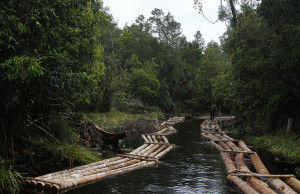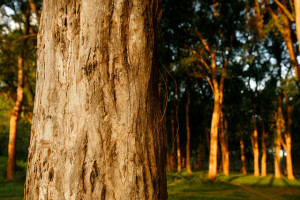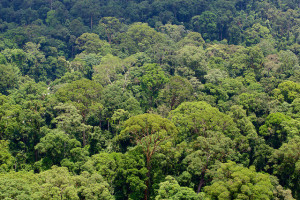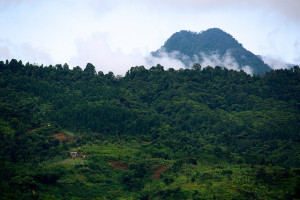By Romain Pirard, originally published at CIFOR’s Forests News

Large-scale mono-culture plantations have been criticized for a bevy of reasons: land grabbing, forest destruction, poor environmental services, unfair distribution of benefits, and the list goes on.
So it might sound counter-intuitive, and even provocative, to suggest timber plantations as a prime solution to promote forest conservation. Yet this forms the basis of a theory derived during the early 20th century, which this article will refer to as the ‘plantation conservation benefit’ theory. It stipulates that generating value out of wood production is actually an effective way to protect a given tract of forest.
To examine this theory, let’s go back to its origin. The starting point sounds reasonable enough: by planting trees at scale to be managed intensively in order to achieve higher productivity, one can produce enough timber to spare the remaining natural forests. In other words, one can substitute wood derived from the forests with wood produced from the timber plantations.
To further test this theory, we reviewed evidence in a recently published study.
A first observation is that although not much research has been completed – or at least published – a wealth of information exists. This is primarily because the research draws upon an amazing diversity of methods. Each of these methods allows scientists to look at different angles of the question, which appears to be as complex as it seems straightforward.
These methods include pure descriptive statistics that illustrate long-term trends. For instance, research shows that wood production from natural forests actually peaked in 1989 and plantations are filling the gap.

Another research method uses theoretical modeling, which highlights the risk of displacement effects. For instance, establishing a timber plantation in one area could displace agriculture to another forested area, which is not easy to track, but definitely determines the ultimate impacts of plantations.
Yet another way to approach the issue is by using econometric models. These lead to other possible scenarios. For instance, efficient and productive management of expanding plantations could result in the oversupply and enhanced demand of timber, as consumers react to lower market prices. The danger here is creating new demand for wood. After all, why wouldn’t someone want to replace his or her plastic chairs with fancy wooden ones if timber was rendered more affordable?
MORE TIMBER, MORE TREES
So what can we learn from this diversity of approaches and studies, apart from fancy theories and anecdotal evidence?
Although the evidence is not entirely straightforward, there is some convergence in findings. Most importantly, it seems that the assumption holds to some extent, however disturbing that might sound to those who oppose the expansion of tree plantations for their alleged (and at times, proven) flaws.
This is not to say that the ‘plantation conservation benefit’ theory is entirely rosy, but overall, it can be inferred from the research that an increased supply of wood plantations tends to reduce pressure on natural forests.
We should insist on this last point and further clarify: more plantations might indeed alleviate the pressure on natural forests by sharing the burden of production, but this refers to wood extraction only.

What does this mean? It means that less timber production from natural forests, hence less degradation, also means less value (both recognized and marketed) for standing forests.
This is a critical aspect to highlight. When natural forests are not used for wood extraction – which can be done in sustainable ways like using reduced impact-logging techniques – they may actually be more vulnerable to clear-cutting.
Generating value out of wood production may indeed become the most effective way to protect a tract of forest. In contrast, using forests solely for environmental services might not be enough to shield it against other land uses, particularly agriculture. So the trick here is not to remove one problem, only to create a bigger one.
SUCCESS FACTORS
This suggests that a number of parameters will have to be carefully considered before designing programs to develop plantations that will also promote conservation. Obviously, plantations should not be established on already forested areas (even though they can be much more productive per hectare, from just a few m3 up to 20-40 m3/ha), or on areas where restoration could be given priority.
Additionally, wood extraction in natural forest ecosystems cannot be dismissed on principle. Not only do forests provide high-quality wood products that plantations might not be able to yield (requiring super long rotations lasting dozens of years, if not centuries), but it can also be done in fairly sustainable ways (yet premiums for such sustainable techniques might not be high enough to encourage large-scale adoption).

Although providing value to forests via sustainable timber production would encourage policymakers to preserve them in the face of mounting pressure from agriculture, economic reasons alone aren’t enough. Law enforcement is another necessary condition for the ‘plantation conservation benefit’ to materialize. Regardless of the amount of timber supplies produced from plantations, natural forests will unfortunately always be tempting to access for production given that their stocks are ready for use.
Admittedly, with so many policies and conditions to be met in order for the ‘plantation conservation benefit’ to materialize, one may wonder if it is more theoretical than operational.
And the fact that plantations seem to be taking over, as is very clearly suggested by numbers showing substitution of production from forests to plantations, could conceal an ugly truth: this transition might actually be the consequence of declining production potential in natural forests.
Bear with me, as this is more than simply subtle nuance. If plantations are only responding to necessity with decreasing wood production potential in natural forests, and are filling the gap between supply and demand, then they should not be ascribed the responsibility for conservation resulting from the shift.
This matters because the benefits of plantation expansion might then only be for consumers enjoying sustained volumes of wood available on the market, and not for the sake of conserving tropical forests.
Yet for all of the weaknesses of the ‘plantation conservation benefit’ theory, and based on published evidence, one cannot deny that there is some truth in it. This is an encouragement to continue to design plantation programs that pay a great deal of attention to the mitigation of negative impacts, as well as investing in parallel programs to sustainably manage or protect remaining natural forests.
After all, the expansion of timber plantations could prove to be a necessary condition (albeit insufficient if applied in isolation) to promote the conservation and the survival of natural forests.











